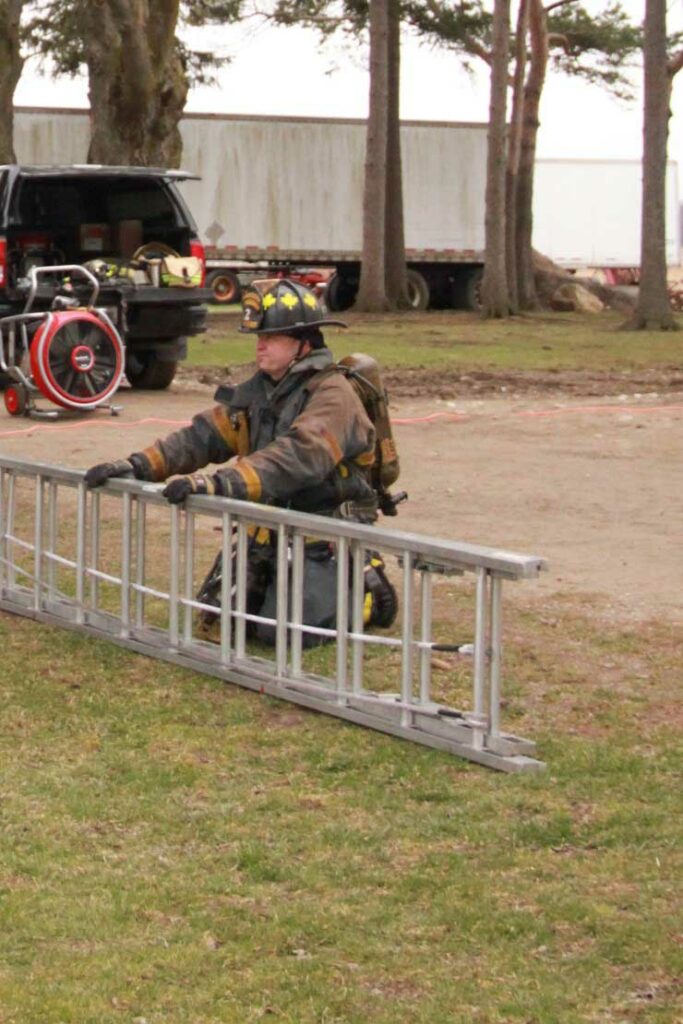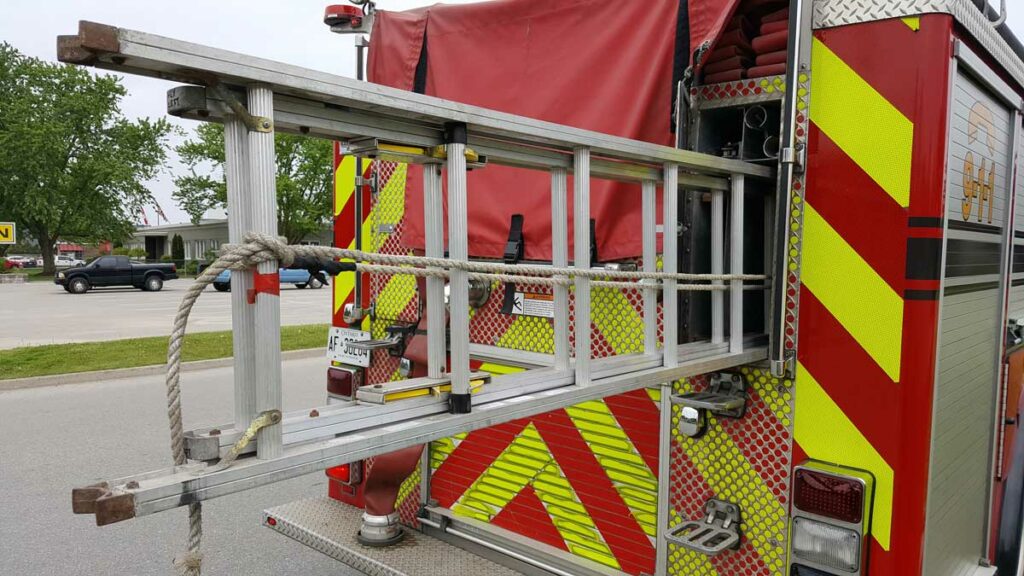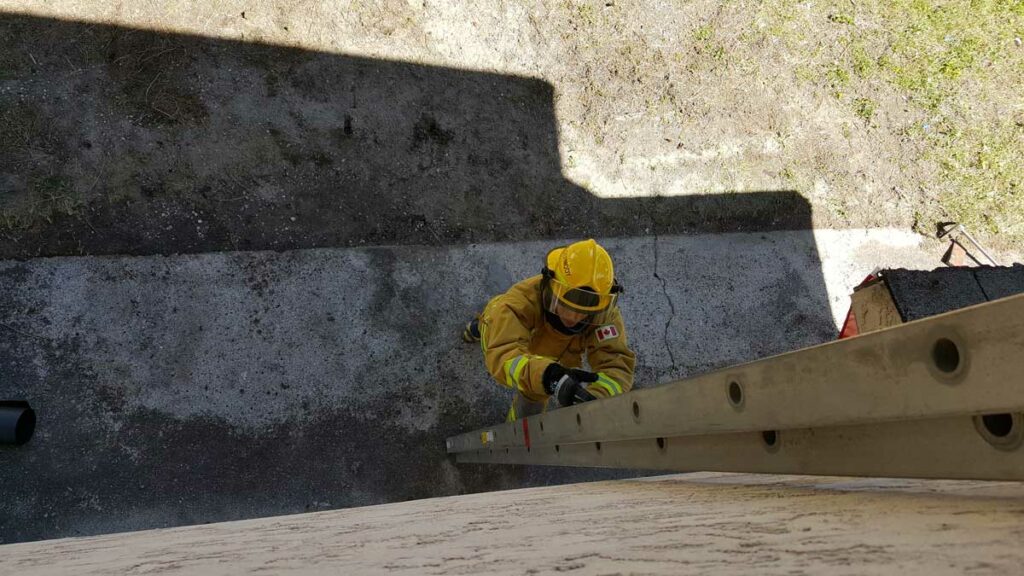Given our limited staffing, firefighters must learn to be effective and efficient with fewer hands on deck. This may mean working alone at accomplishing certain tasks. The idea of single-firefighter assignments may go against the grain of what we have been taught for a long time—always work in pairs at a minimum—but the reality is that we find ourselves operating this way to get things done on the fireground.
- Throw Back to Basics: High Shoulder Carry
- One-Firefighter Ladder Carry
- Operational Variations for Ground Ladders
- Throw Back to Basics: Roof Ladders
Is this safe? I believe that it is, but the question is open to debate with strong arguments on both sides. This month we look at a single-firefighter task that is relatively safe and easy to accomplish: the high-shoulder ladder throw.
This operation can be accomplished by any one firefighter: driver, pump operator, the first firefighter of a two-man team, the officer, etc. It is a task that any one person can accomplish with ease. Laddering a building needs to be a single-firefighter assignment; this is where we need to divide our available manpower on scene with the tasks that need to be accomplished. Laddering a building is a safety point for both the firefighters inside as well as for occupants who may need to be rescued. This does not require two firefighters to do—a potential waste of manpower for the incident commander.
The high-shoulder ladder throw is perfect for the newer fire trucks being manufactured that have a ladder compartment or a ladder rack that folds down, presenting the ladder at shoulder height. It also works for the traditional static ladder rack that is positioned on the side of the truck, also at shoulder height. Whenever the ground ladder is positioned at a height well above the shoulder, it is not beneficial for any type of operation, as it will take significant time to just get the ladder off the truck.

The first step in making this ladder throw successful is to mark or identify the middle of the ladder. This can be accomplished in several ways, such as that depicted in photo 1. The ladder is tagged as L223, which both identifies which fire truck it belongs and indicates the middle of the ladder. Another way is to use spray paint to mark the middle of the ladder. The spray paint color can also be an identifier for which truck it belongs to. By marking the middle of the ladder, firefighters can visually tell and know where the mid-point of the ladder is for carrying purposes. This will allow us to grab the ladder in the right place the first time without delay.

The second item to consider is the halyard. It needs to be tied in a manner that will allow one firefighter to raise and then extend the ladder without having to untie the halyard. This can be accomplished as shown in photos 2 and 3. The halyard is tied around the bottom rung of the bed section using a clove hitch and stays that way always. When it comes time to extend the fly section of the ladder, all you must do is pull on the halyard and up goes the ladder.

The third item to consider is the orientation of the ground ladder on the truck, either in a compartment as shown in photo 3 or on a ladder rack. The ground ladder must be orientated with the bed section toward the firefighter. This allows the one firefighter to pull the ladder out from the compartment up to the mid-point of the ladder, then place his or her shoulder underneath the bottom beam of the bed section at the mid-point and walk the rest of the ladder away from the truck. It also allows the one firefighter to raise the ground ladder and then be able to extend the fly section easily using one or two hands with the halyard facing him or her, as shown in photo 4.

To pull off the high shoulder load throw, the ladder needs to be completely on top of the firefighter’s shoulder, as in photo 5. This means getting used to balancing the ladder on your shoulder with the ladder in this orientation. The firefighter will have to use one hand to hold the rung of the ladder while freeing up the other hand to carry some hand tools, if necessary. If both hands are available, they can both be used to hold the ladder rungs while carrying it.

Once the firefighter has reached the destination, he or she will direct the butt spurs of the ladder into the ground. Then, with a single push on the beam, he or she will raise the ladder vertically up. At this point the ground ladder will be facing backwards to the building, fly section towards the building, bed section towards the firefighter. The firefighter can now extend the fly section of the ladder.
Once the ladder has been extended to where it needs to be, the firefighter must place the ladder against the building, with the butt end moved out away from the building to allow for the ladder tip to fall down to where it needs to be. Then the ladder can be flipped over so that it will be in the right orientation to the building, fly section out.
Bringing the ladder back down is the opposite of putting it up. The learning curve for firefighters will be to know when to put the mid-point of the ground ladder on their shoulder to once again have it completely on their shoulder.

Mark van der Feyst has been in the fire service since 1999 and is a firefighter with the Fort Gratiot (MI) Fire Department. He is an international instructor teaching in Canada, the United States, and India, and at FDIC. He is also the lead author of Residential Fire Rescue (Fire Engineering Books & Video). He can be contacted at Mark@FireStarTraining.com.

